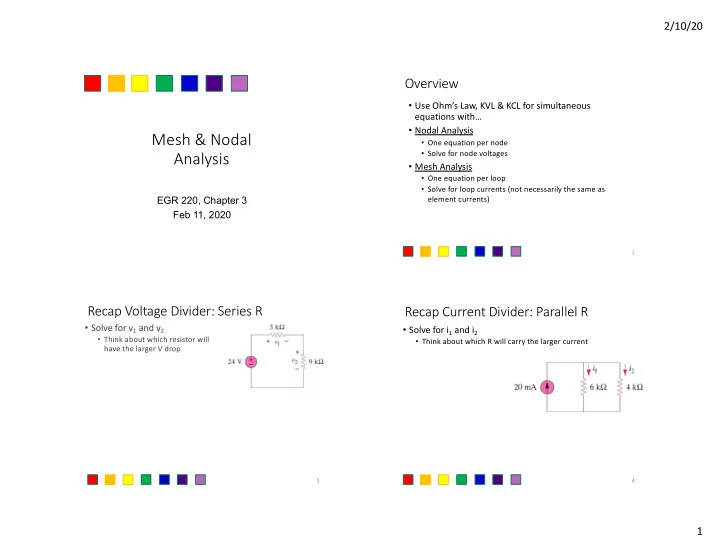

2/10/20 Overview • Use Ohm’s Law, KVL & KCL for simultaneous equations with… • Nodal Analysis Mesh & Nodal • One equation per node Analysis • Solve for node voltages • Mesh Analysis • One equation per loop • Solve for loop currents (not necessarily the same as element currents) EGR 220, Chapter 3 Feb 11, 2020 2 Recap Voltage Divider: Series R Recap Current Divider: Parallel R • Solve for v 1 and v 2 • Solve for i 1 and i 2 • Think about which resistor will • Think about which R will carry the larger current have the larger V drop 3 4 1
2/10/20 Write Expressions for I, using Ohm’s Law & “V drop ” Write Expressions for I, using Ohm’s Law & “V drop ” 5 6 Nodal Analysis Nodal Analysis • How do we find v 1 , v 2 and power dissipated in the • Apply Kirchhoff’s current law to solve for nodal resistors? voltages 1) Label diagram (nodes, all directions) • Initial labeling is arbitrary but must be consistent! 2) Obtain equations using KCL and substituting in Ohm’s law 3) Solve equations for nodal voltages • Substitutions, linear algebra (matrices), Matlab • Note, negative answers indicate polarity is opposite your initial assumptions and are not incorrect • Solution often requires iteration, as first attempt may not work. 9 10 2
2/10/20 11 12 Concept Check: Voltage Across Mesh Analysis • Apply Kirchhoff’s voltage law to solve for loop • v 1 , v 2 are voltage values relative to what? (mesh) currents • What is the voltage across the 4Ω resistor? • Other law(s), expression(s) to use? • Process? 1) 2) 3) 13 14 3
2/10/20 Mesh Analysis Warmup Mesh Analysis Warmup • How do we find (and label) i through R 3 ? If we draw loop currents to be opposing through R 3 ... • Mesh currents versus element currents (linearity for resistor behavior; superposition of sources) 15 16 Mesh Analysis Mesh Analysis • Write equations for I 1 , I 2 , I 3 and I • How do we find I 1 , I 2 , I 3 and I ? I • Set up equations • ( be able to write equations in matrix format ) I 17 18 4
2/10/20 Use Matlab to solve… Practice Circuit Analysis 1 • Find all currents and voltages >> R = [7 2 1; 2 12 0; 1 0 6] R = 7 2 1 2 12 0 1 0 6 >> V = [8; 6; 2] V = 8 I 6 2 >> I = inv(R) * V I = 1.0256 0.3291 0.1624 19 20 Discussion Circuit Analysis • Find all currents and voltages • How can you find the voltages indicated? • Compare ability to use nodal analysis vs. mesh analysis. 21 22 5
2/10/20 Practice Circuit Analysis 2 • How to find the voltages indicated? • Find all currents and voltages v 2 v 3 v 1 23 24 • Find all currents and voltages Practice Analysis v 2 v 1 v 3 25 26 6
2/10/20 Practice Analysis Practice Analysis (posted) • How would we apply the tools learned so far? • KCL à Nodal analysis • KVL à Mesh analysis • Current or voltage divider with R eq ? 27 Practice Analysis Analysis Tools • Ohm’s law • KVL: Kirchhoff’s voltage law • KCL: Kirchhoff’s current law • Equivalent resistance • Current divider • Voltage divider • Mesh analysis • Nodal analysis à Exam 1 Through Mesh & Nodal ß • Next core theorem: Thevenin Equivalent Circuit 30 7
2/10/20 Important Notes Lab 3: Linearity • Read the text book! 4 • We have limited in-class time • Check out the applets link • on webpage from the first week of class • Homework 2 • show and develop clear thinking • learn from the homework 31 32 Lab 3 Preview Lab 3: Superposition • Design your own lab – to verify Superposition and Linearity in circuits • Read the chapter to begin learning these analysis methods • Use simple circuits from the chapter to get ideas for your circuits, to build and test in the lab • Pre-lab – design your lab experiment • Design it for 1 ¾ hour, allow time for mistakes and learning as you go, in our 2 ½ hour lab time. 33 34 8
2/10/20 Lab 2 Experiments – Find R Multimeter Lab 2 Experiments – Find R Multimeter R = 10MΩ R = 10kΩ 35 36 9
Recommend
More recommend